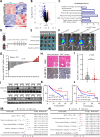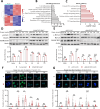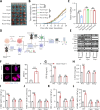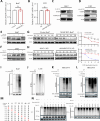Degradation of PARP1 by MARCHF3 in tumor cells triggers cCAS-STING activation in dendritic cells to regulate antitumor immunity in hepatocellular carcinoma
- PMID: 39608977
- PMCID: PMC11605840
- DOI: 10.1136/jitc-2024-010157
Degradation of PARP1 by MARCHF3 in tumor cells triggers cCAS-STING activation in dendritic cells to regulate antitumor immunity in hepatocellular carcinoma
Abstract
Background: Resistance to immune checkpoint inhibitors (ICIs) significantly limits the efficacy of immunotherapy in patients with hepatocellular carcinoma (HCC). However, the mechanisms underlying immunotherapy resistance remain poorly understood. Our aim was to clarify the role of membrane-associated ring-CH-type finger 3 (MARCHF3) in HCC within the framework of anti-programmed cell death protein-1 (PD-1) therapy.
Methods: MARCHF3 was identified in the transcriptomic profiles of HCC tumors exhibiting different responses to ICIs. In humans, the correlation between MARCHF3 expression and the tumor microenvironment (TME) was assessed via multiplex immunohistochemistry. In addition, MARCHF3 expression in tumor cells and immune cell infiltration were assessed by flow cytometry.
Results: MARCHF3 was significantly upregulated in tumors from patients who responded to ICIs. Increased MARCHF3 expression in HCC cells promoted dendritic cell (DC) maturation and stimulated CD8+ T-cell activation, thereby augmenting tumor control. Mechanistically, we identified MARCHF3 as a pivotal regulator of the DNA damage response. It directly interacted with Poly(ADP-Ribose) Polymerase 1 (PARP1) via K48-linked ubiquitination, leading to PARP1 degradation. This process promoted the release of double-strand DNA and activated cCAS-STING in DCs, thereby initiating DC-mediated antigen cross-presentation and CD8+ T-cell activation. Additionally, ATF4 transcriptionally regulated MARCHF3 expression. Notably, the PARP1 inhibitor olaparib augmented the efficacy of anti-PD-1 immunotherapy in both subcutaneous and orthotopic HCC mouse models.
Conclusions: MARCHF3 has emerged as a pivotal regulator of the immune landscape in the HCC TME and is a potent predictive biomarker for HCC. Combining interventions targeting the DNA damage response with ICIs is a promising treatment strategy for HCC.
Keywords: Hepatocellular Carcinoma; Immune Checkpoint Inhibitor; Immunotherapy; Tumor microenvironment - TME.
© Author(s) (or their employer(s)) 2024. Re-use permitted under CC BY-NC. No commercial re-use. See rights and permissions. Published by BMJ.
Conflict of interest statement
Competing interests: No, there are no competing interests.
Figures







Similar articles
-
Targeted nanosensitizer-augmented sono-immunotherapy with STING agonist to remodel the immune microenvironment in hepatocellular carcinoma.Acta Biomater. 2025 Jun 1;199:387-397. doi: 10.1016/j.actbio.2025.05.029. Epub 2025 May 9. Acta Biomater. 2025. PMID: 40349900
-
CRKL dictates anti-PD-1 resistance by mediating tumor-associated neutrophil infiltration in hepatocellular carcinoma.J Hepatol. 2024 Jul;81(1):93-107. doi: 10.1016/j.jhep.2024.02.009. Epub 2024 Feb 23. J Hepatol. 2024. PMID: 38403027
-
Disruption of tumor-intrinsic PGAM5 increases anti-PD-1 efficacy through the CCL2 signaling pathway.J Immunother Cancer. 2025 Jan 7;13(1):e009993. doi: 10.1136/jitc-2024-009993. J Immunother Cancer. 2025. PMID: 39773565 Free PMC article.
-
Strategies to Improve the Antitumor Effect of Immunotherapy for Hepatocellular Carcinoma.Front Immunol. 2021 Nov 26;12:783236. doi: 10.3389/fimmu.2021.783236. eCollection 2021. Front Immunol. 2021. PMID: 34899747 Free PMC article. Review.
-
Role and therapeutic potential of E3s in the tumor microenvironment of hepatocellular carcinoma.Front Immunol. 2024 Oct 31;15:1483721. doi: 10.3389/fimmu.2024.1483721. eCollection 2024. Front Immunol. 2024. PMID: 39544935 Free PMC article. Review.
Cited by
-
Deciphering cGAS-STING signaling: implications for tumor immunity and hepatocellular carcinoma.Naunyn Schmiedebergs Arch Pharmacol. 2025 May 7. doi: 10.1007/s00210-025-04240-6. Online ahead of print. Naunyn Schmiedebergs Arch Pharmacol. 2025. PMID: 40332552 Review.
-
The ATF4-glutamine axis: a central node in cancer metabolism, stress adaptation, and therapeutic targeting.Cell Death Discov. 2025 Aug 19;11(1):390. doi: 10.1038/s41420-025-02683-7. Cell Death Discov. 2025. PMID: 40830338 Free PMC article. Review.
-
Ubiquitination in hepatocellular carcinoma immunity.J Transl Med. 2025 May 23;23(1):574. doi: 10.1186/s12967-025-06592-2. J Transl Med. 2025. PMID: 40410880 Free PMC article. Review.
-
Immune microenvironment in hepatocellular carcinoma: from pathogenesis to immunotherapy.Cell Mol Immunol. 2025 Jun 11. doi: 10.1038/s41423-025-01308-4. Online ahead of print. Cell Mol Immunol. 2025. PMID: 40500404 Review.
-
Olaparib Combined with Anti-PD1 Enhances Immunotherapy of Gastric Cancer Via NF-κB/c-Myc/PD-L1 Signaling.Dig Dis Sci. 2025 Jun;70(6):2032-2042. doi: 10.1007/s10620-025-09021-y. Epub 2025 Apr 16. Dig Dis Sci. 2025. PMID: 40237904 Free PMC article.
References
MeSH terms
Substances
LinkOut - more resources
Full Text Sources
Medical
Research Materials
Miscellaneous
